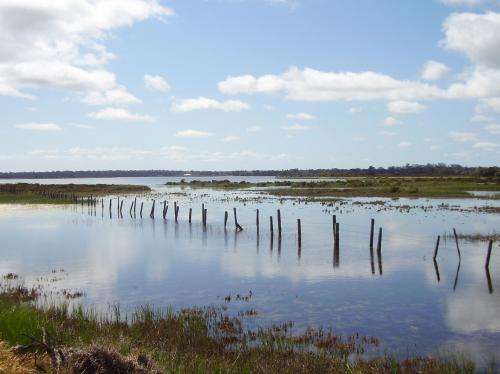Researchers say the problems with the Vasse River may take time to fix. Credit: Tsun-Thai Chai Wikimedia Commons
Findings from an 11 year study into south-western Australian rivers show a reduction in toxic algal blooms in the Canning River—whilst the Vasse River continues to suffer.
The study, conducted by Murdoch University's Peter Novak and Jane Chambers from 1996 to 2007, examined the remediation of the Canning and Vasse Rivers through the growth of introduced aquatic plants.
"Although there has been a lot of remediation down at the Vasse, the water there is far too enriched in nitrogen and phosphorus to allow the plants to grow that well," co-author Peter Novak says.
"We found in the Canning [River], that the remediation had improved the conditions [giving] the plants an advantage.
"In that river we probably would have more success introducing a number of other species that may help maintain the dominance of the plants."
Algal blooms are rapid increases in algae that are toxic for humans and also decrease the biodiversity of aquatic systems.
The blooms are due to an increase in the concentration of phosphorus and nitrogen in the system.
"Both [the Canning and Vasse] rivers drain urban and agricultural catchment," Mr Novak says.
"[Phosphorus and nitrogen] will continue to come into those rivers for as long as fertilisers are applied or those sources are there.
"Even if we were to dock those sources of nutrients … there's so much in the ground water it's going to keep moving into that system for the next few decades."
Macrophytes owed for Canning's success
The success of the Canning River's restoration can be partly attributed to its large population of oxygen producing aquatic plants (macrophytes), which reduce the severity of algal blooms.
The study found the restoration to the Canning River had actually increased the macrophytes resulting in a lack of algal blooms between 2005 and 2007.
The main applicant used in the restoration process is Phoslock; a clay that is sprayed onto water as a fine slurry.
"The clay particles slowly sink through the water column," Mr Novak says.
"They attract and lock up any phosphorus in the water they come in contact with [and] then form a layer on the [bottom] to catch any phosphorus that would be coming up from the sediment."
Unfortunately the problems with the Vasse River may take time to fix.
"There is a possibility that you might be able to get plants established there that will reduce the severity of the algal blooms; but it is going to take some time," says Mr Novak.
More information: Peter A. Novak, Jane M. Chambers," Investigation of nutrient thresholds to guide restoration and management of two impounded rivers in south-western Australia," Ecological Engineering, Volume 68, July 2014, Pages 116-123, ISSN 0925-8574, dx.doi.org/10.1016/j.ecoleng.2014.03.091.
Journal information: Ecological Engineering
Provided by Science Network WA






















